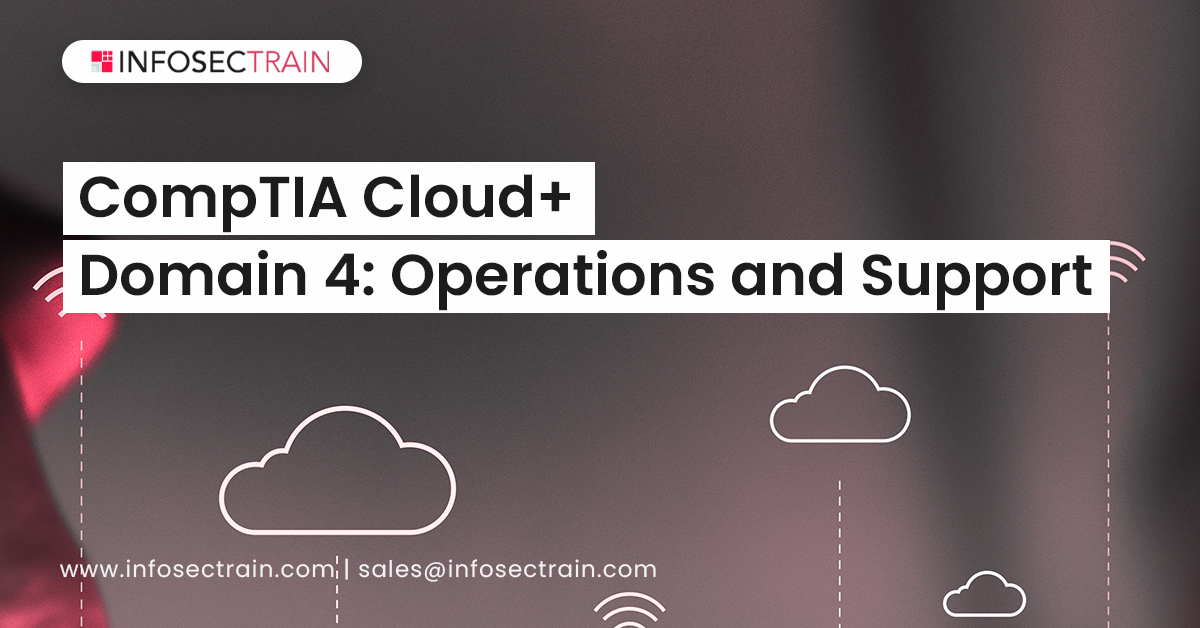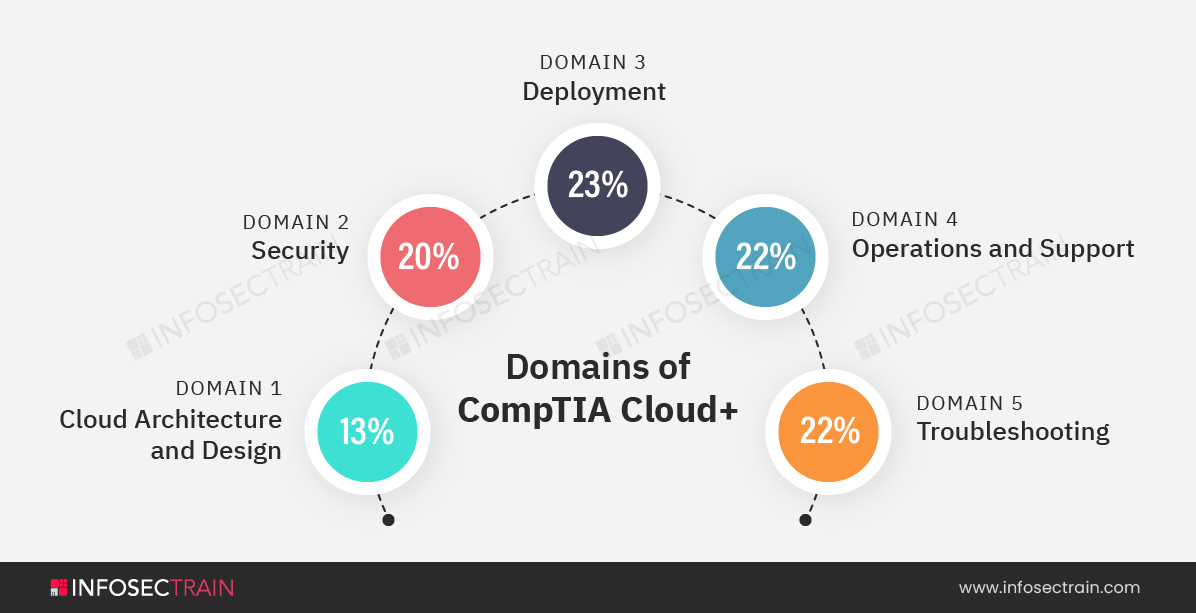CompTIA Cloud+ Domain 4: Operations and Support

Domains of the CompTIA Cloud+

CompTIA Cloud+ certification comprises a total of five domains:
- Domain 1: Cloud Architecture and Design 13%
- Domain 2: Security 20%
- Domain 3: Deployment 23%
- Domain 4: Operations and Support 22%
- Domain 5: Troubleshooting 22%
We will discuss the fourth domain that is ‘Operations and Support’.
Operations and Support
The Operations and Support phase is abbreviated as the O&S phase that focuses on carrying out the product support strategy, meeting material readiness and operational performance criteria, and supporting the system in the most cost-effective way possible throughout its life cycle. The Operations and Support discipline’s main objective is to run and support your product in a live environment. This domain comprises the second-highest amount of weightage that is 22%, so it is an important domain. This domain will provide an overview of topics like operation status, efficient operation, optimizing cloud environments, automation and orchestration techniques, backup and restore operations, and disaster recovery.
1. Configure logging, monitoring, and alerting to maintain operational status
In this sub-domain, we learn to configure logging, monitoring, and alerting to maintain operational status in a given scenario. This domain will equip us with an in-depth understanding of logging, monitoring, and alerting. In logging, we will learn about collectors and types. Collectors explain the Simple Network Management Protocol (SNMP), and Syslog whereas the types define access/authentication, system, and application. We will also learn many different things like analysis, severity categorization, audits, automation, and trending. Monitoring provides an in-depth understanding of baselines, thresholds, tagging, log scrubbing, resource utilization, verification of continuous monitoring activities, service management tool integration, performance monitoring that incorporates application, and infrastructure components, and availability that incorporates SLA-defined uptime requirements. Alerting will take you through common messaging methods, appropriate responses, policies for categorizing and communicating alerts, and enable/disable alerts that explain maintenance mode.
2. Maintain efficient operation of a cloud environment
In this sub-domain, we learn to maintain the efficient operation of a cloud environment in a given scenario. We will get an understanding of the topics like confirm completion of backups, life-cycle management, change management, asset management, patching, impacts of process improvements on systems, upgrade methods, dashboard, and reporting. In the studies of life cycle management, we will learn about roadmaps, old/current/new versions, upgrading and migrating systems, and deprecations or end of life. We will learn about Configuration Management Database (CMDB) under asset management while in patching, we will learn all about features or enhancements, fixes for broken or critical infrastructure or applications, the scope of cloud elements to be patched, hypervisors, VMs, virtual appliances, networking components, applications, storage components, firmware, software, OS, policies, n-1, and rollbacks. In upgrade methods, we learn about rolling upgrades, blue-green, canary, active-passive, and development/QA/production/DR. In dashboard and reporting, we will learn about tagging, costs, chargebacks, show backs, elasticity usage, connectivity, latency, capacity, incidents, health, overall utilization, and availability.
3. Optimize cloud environments
In this sub-domain, we learn to optimize cloud environments in a given scenario. This sub-domain will equip you with the knowledge of right-sizing, compute, storage, network, placement, device drivers, and firmware. In right-sizing, we will learn about auto-scaling, horizontal scaling, vertical scaling, and cloud bursting, while in compute, we will learn about CPUs, GPUs, memory, and containers. We will learn about tiers, adaptive optimization, IOPS, capacity, deduplication, and compression in storage. We will learn about bandwidth, Network Interface Controllers (NICs), latency, SDN, edge computing, and CDN in the network. Placement will give us an idea of geographical, cluster placement, redundancy, and colocation. In device drivers and firmware, we will learn about the generic, vendor, and open source.
4. Apply proper automation and orchestration techniques
In this sub-domain, we learn to apply proper automation and orchestration techniques in a given scenario. We will gain knowledge of infrastructure as code, Continuous Integration/Continuous Deployment (CI/CD), version control, configuration management, containers, automation activities, secure scripting, and orchestration sequencing. In infrastructure as code, we will understand infrastructure components and their integration while the configuration management will provide knowledge of the playbook. The automation activities equip you with the idea of routine operations, updates, scaling, shutdowns, restarts, and create internal APIs. The secure scripting will take you through no hardcoded passwords, use of individual service accounts, password vaults, and key-based authentication.
5. Perform appropriate backup and restore operations
In this sub-domain, we learn to perform appropriate backup and restore operations in a given scenario. It will provide you in-depth knowledge of backups like backup types, backup objects, backup targets, backup and restore policies, and restoration methods. The topic backup types incorporate incremental, differential, full, synthetic full, and snapshot. In backup objects, we will learn about application-level backup, filesystem backup, database dumps, and configuration files. The topic backup targets will be brief about tape, disk, and object. Backup and restore policies will provide the knowledge of retention, schedules, location, SLAs, Recovery Time Objective (RTO), Recovery Point Objective (RPO), Mean Time To Recovery (MTTR), and 3-2-1 rule that is three copies of data, two different media, and one copy off-site. In restoration methods, we learn things like in place, alternate location, restore files, and snapshot.
6. Perform disaster recovery tasks
In this sub-domain, we learn to perform disaster recovery tasks in a given scenario. We learn all about failovers, failback, restore backups, replication, network configurations, on-premises and cloud sites, requirements, documentation, and geographical data center requirements. The topic on-premises and cloud sites provide knowledge of hot, warm, and cold sites. The topic requirements will teach you all about RPO, RTO, SLA, and corporate guidelines. In the documentation, we will learn about the DR kit, playbook, and network diagram.
CompTIA Cloud+ with InfosecTrain
For expert knowledge and an in-depth grasp of Cloud security, consider taking the CompTIA Cloud+ Certification Training Course from InfosecTrain. Instructors that are highly trained and experienced are in charge of this training. With our well-versed and experienced teachers, we are among the leading training providers in the globe. The courses will assist you in grasping the fundamental principles and providing a thorough understanding of the subject. This certification is well worth every dollar and minute you put into it.




 1800-843-7890 (India)
1800-843-7890 (India) 
